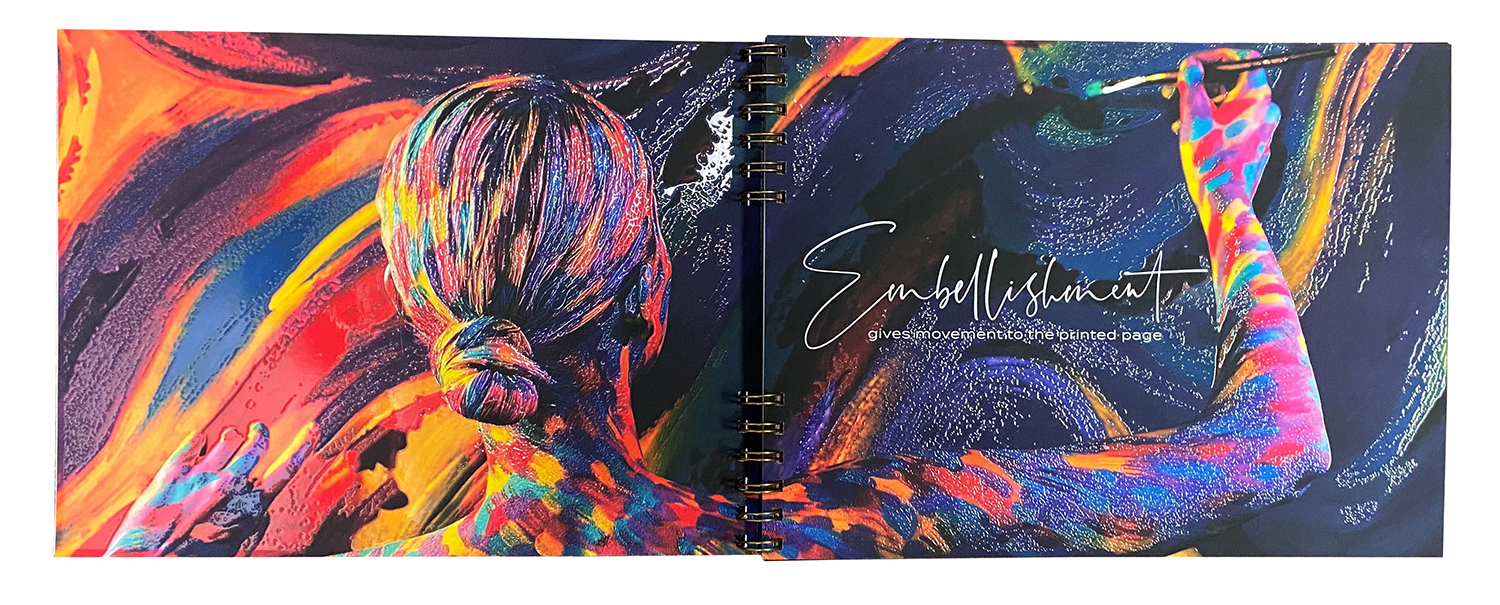
By Liz Stevens, writer, PostPress
Specialty UV coatings have grown in popularity with the increase of digital inkjet processes and conventional screen UV coatings as well. To take full advantage of the creativity offered by UV coatings, it is helpful to understand their strengths and weaknesses as dictated by the underlying press being used – traditional vs. digital. And it takes design expertise to use UV coatings for the most effective and memorable results. FSEA Executive Director Jeff Peterson spoke with a trio of printing experts who have mastered the use of UV coatings. Doug Fontana from The Fontana Group, Christine Yardley of Print Panther and Matt Greer with DMS Color shared valuable best practices, practical suggestions and design ideas for using specialty and spot UV to make print pieces sing, pop and make a lasting impression. They also showed examples of UV coating applications on some of their favorite recent projects.
Making the most of UV coatings
“The use of spot UV usually is to highlight something,” said Doug Fontana. “Whether it is text or a logo or a product, the aim is to make it stand out from the background. That can be done by using contrast – using a gloss UV with a matte background or using matte UV with a gloss background. A soft-touch feel, or a rough feel, can add contrast, too. Designers even can use spot UV with glitter, but the main technique that designers would use is to add contrast to really make the artwork pop.”
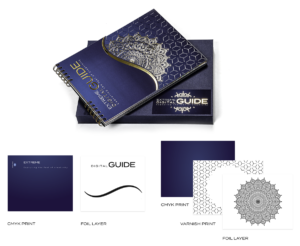
Fontana mentioned some new spot UV coatings that are gaining notice. “We call them ‘reveal’ coatings,” he said. “There is a thermal coating that completely covers an image; when heat is applied – the heat of a finger, for instance – the image beneath the coating appears. There is lottery ticket-style reveal with a scratch-off coating.” Fontana also described a coating called a flash reveal; the hidden image can’t be seen unless the viewer takes a picture of it with a phone camera using a flash. “All of a sudden,” Fontana said, “the hidden image will show up in the phone’s picture, but on the original print the image cannot be seen with the naked eye.” There also is a hydrochromic reveal – a water-based coating concealing an image that will appear if moisture is applied, like a litmus test.
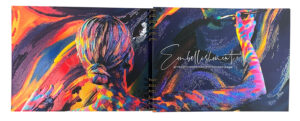
Fontana stated that it is best to avoid using UV to highlight a white element – a logo or text, for example. “It just doesn’t work to get a pop on something that is white on a background of another color,” he said. “The background color always is going to dominate the image.” Black, however, loves UV. “If you put spot UV on black, it shows up fantastically.” Fontana also avoids using raised UV on large areas. “Raised UV is all about the sense of touch,” he said. As with the contrast between matte and gloss, raised UV works best if there are peaks and valleys in the image. “A finger, a person’s sense of touch, feels all of those differences which bring the wow factor to a piece,” he said. “I always tell a designer: Avoid big silhouettes of raised UV. Break up the pattern to get a lot more contrast out of it.”
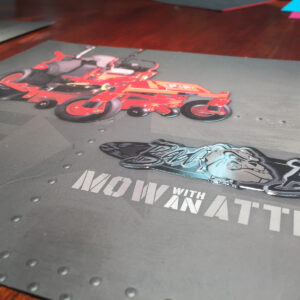
Christine Yardley, president of Print Panther, Oakville, Ontario, Canada, seconded Fontana on the use of UV coatings to highlight an element of a print design. “Whether the element is the photograph or the logo, it is about capturing interest by highlighting an element,” she said. Yardley likes to use multiple passes with UV coating over digital foil for a raised effect but, like Fontana, she stays away from using UV coatings on large areas. “I use the spot varnish, for instance, if I am doing a large foil area that could scratch or get damaged,” she said. “Putting a clear varnish on top protects my foil.” She advised using spot varnish thoughtfully. “When I work with a designer, I ask what are we trying to capture here? What is the most important thing? Brands want consistency,” she explained. A brand doesn’t want to completely change its look, but by adding a bit of varnish and capturing a bit of interest on a campaign or a print ad, it can keep its branding consistent and just add that little bling factor. It can’t always be done with foil, but with varnish it’s a pretty simple way of capturing interest that does not go off brand.” Yardley also appreciates that digital printing allows for adding spot varnish in sync with variable elements; for example, personalizing each piece with a person’s name and using spot varnish on top of the black text to make it stand out.
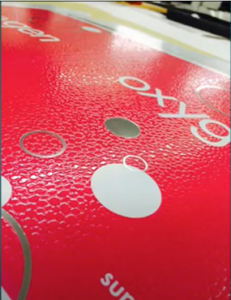
Matt Greer, CEO/CTO of DMS Color in Pelham, Alabama, added his experience with UV coatings. “There are different ways to spin the use of coatings,” he said. “I usually preach the ‘less is more’ concept. When we look at a project, we don’t necessarily always pull an element out with gloss coating; sometimes we want to add texture, to feel the element in the hand.” For texture on an image of a lizard, for example, Greer said that it might take multiple passes of varnish to build up the reptile’s scales, but since process varnish is not inexpensive, he always designs with cost in mind. “We also are very keen on making sure we have gutters that are not on score lines and around cut marks, so that we don’t have any issues with anything cracking or potentially losing its adhesiveness,” said Greer.
Communicating advantages and disadvantages of UV coating processes
Fontana explained the unique qualities and benefits that traditional screen UV coating processes have to offer and that should be communicated to the end user or designer. “Our strongest advantages are in the large-run, large-sheet, large-format type of work,” said Fontana. “We usually are running 28″ x 40″ sheets. If the item is a carton, let’s say 300,000 cartons for the job, you can fit 10 of them on a half sheet or 20 on a full sheet. We can put 20 cartons on a sheet and print 15,000 sheets. The speed and sheet-size capacity are the biggest advantages.” Another advantage, said Fontana, is that using a screen for UV coatings allows for a lot of experimentation. “Anything that can fit through the screen can be run without damaging the press,” he said. Fontana pointed out that the reveal coatings he described likely are only available with traditional UV coating processes, and he stressed that with traditional screen printing, it is possible to apply coatings at a specified thickness in a single pass, unlike the multiple passes required for digital coating processes.
The disadvantages of traditional processes, said Fontana, include the consumables and labor involved. He illustrated this by explaining that his company has an employee solely dedicated to screens. “All he does is make screens, prepare screens, clean screens and store screens.” Fontana explained that set-up and the tooling costs are disadvantages of the more traditional UV coating process. However, for longer runs, these costs can be absorbed and will help keep costs down for a large project overall. So, it is important, from a design perspective, that the designer understands what type of coating process will work best for the print job.
How digital stacks up for specialty and spot coatings
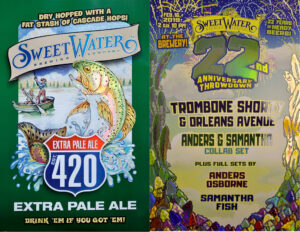
Greer laid out how digital decorating coatings and foils offer advantages in their run size capabilities and turnaround times. “Digital can do the shorter runs, and it can be on demand,” he said. “We also can enter markets that typically are not available to traditional printers since they are not tooled to enter some markets like e-commerce and short-run packaging.” He noted, however, that with the right mindset, the right talent and the right tools, digital offers unique qualities and can sometimes compete with traditional processes. “We can handle variable data. We can capture different parts of the market – like smaller businesses,” he said, “and offer services that may not have been available to these companies in the past. DMS Color has done several really large mailer jobs, in the hundreds of thousands of pieces, with a person’s name emblazoned across the front of the mailer in holographic foil.” Providing samples of digitally decorated work is important for designers to be able to see what is possible.
Greer admitted, though, that digital cannot offer specialty coatings with characteristics like reveal, thermal-sensitivity or water-solubility. And he noted that digital cannot match the level of image detail that traditional processes can offer. “Our level of detail has not reached what a screen or a foil stamp can do quite yet,” he said. “Right now, for things like fine silver inlays with intricate details or very small text, the traditional side still has the advantage. We do try to mitigate that in our design process by focusing instead on what we can offer as a design with comparable quality.”
Yardley pointed out that designers need to be aware of what types of paper stocks are available for digital decorating processes. “We are limited with our substrates – the thickness of our substrates and the kinds of substrate that we can use,” she said. “We are getting more uncoated stocks that we are able to work with, but these are limited. I often am jealous of the fact that I can’t use some of the uncoated, really toothy stocks that I want to use.” The other thing, she said, is that digital cannot easily produce flat spot UV. “Sometimes I don’t want a raised look,” she said. “Sometimes I want a really flat look, and that is hard to achieve on my system. We can give it a very light skim coat, but it still is not like a traditional, very flat spot UV.”
Like Greer, however, Yardley pointed to digital’s ability to handle variables, to be the answer for short runs and to easily handle multiple passes. “And,” she said, “digital is slightly more sustainable, slightly greener, because digital does not have as much cleanup and chemical use as traditional processes.”
When it comes to embellishing with foil and spot UV coatings on a traditional press or a digital one, approaching the artwork with a designer’s sensibilities and expertise dramatically can elevate the appeal and impact of a piece. With the continued growth of digital and more traditional screen processes for spot specialty UV coatings, designers have a multitude of options to help make their printed materials stand out.

